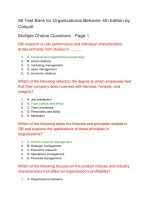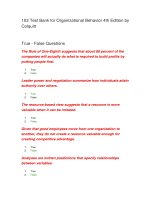Organizational behavior 4th by MShean chap003
Bạn đang xem bản rút gọn của tài liệu. Xem và tải ngay bản đầy đủ của tài liệu tại đây (466.31 KB, 31 trang )
3
Perception and Learning
in Organizations
McGraw-Hill/Irwin
© 2008 The McGraw-Hill Companies, Inc. All rights reserved.
Vodafone Executive Grahame Maher
Vodafone executive
Grahame Maher keeps his
perceptions in focus by
discarding the executive
suite and working alongside
employees every day.
Bob Finlayson/Newspix
McShane/Von Glinow OB4e
Slide 3-2
© 2008 The McGraw-Hill Companies, Inc. All rights reserved.
Perception Defined
The process of selecting,
organizing, and
interpreting information
in order to make sense
of the world around us.
Bob Finlayson/Newspix
McShane/Von Glinow OB4e
Slide 3-3
© 2008 The McGraw-Hill Companies, Inc. All rights reserved.
Perceptual Process Model
Environmental Stimuli
Feeling
Hearing
Seeing
Smelling
Tasting
Selective Attention
Organization and
Interpretation
Attitudes and
Behavior
McShane/Von Glinow OB4e
Slide 3-4
© 2008 The McGraw-Hill Companies, Inc. All rights reserved.
Selective Attention
What is it influenced by?
• Characteristics of the object
– size, intensity, motion, repetition, novelty
• Characteristics of the perceiver
– attitudes
– expectations -- condition us to expect events
McShane/Von Glinow OB4e
Slide 3-5
© 2008 The McGraw-Hill Companies, Inc. All rights reserved.
Perceptual Organization/Interpretation
• Categorical thinking
– Mostly unconscious process of organizing people/things
– Perceptual grouping principles
• Closure -- filling in missing pieces
• Identifying trends
• Similarity or proximity
• Mental models
– Broad world-views or ‘theories-in-use’
– Help us to quickly make sense of situations
– May block recognition of new opportunities/perspectives
McShane/Von Glinow OB4e
Slide 3-6
© 2008 The McGraw-Hill Companies, Inc. All rights reserved.
Social Identity Theory
Oracle Corp.
Employee
Live in the
United States
An Individual’s
Social Identity
University of
Massachussetts
Graduate
McShane/Von Glinow OB4e
Slide 3-7
Employees at
other firms
People living
in other countries
Graduates from
other schools
© 2008 The McGraw-Hill Companies, Inc. All rights reserved.
Social Identity Theory Features
• Categorization process
– compare characteristics of our groups with other
groups
• Homogenization process
– similar traits within a group; different traits across
groups
• Differentiation process
– develop less favorable images of people in groups
other than our own
McShane/Von Glinow OB4e
Slide 3-8
© 2008 The McGraw-Hill Companies, Inc. All rights reserved.
Stereotyping & Social Identity in Engineering
Women are underrepresented
in engineering and computer
science partly because:
– Social identity
• Women dislike the ”geek”
stereotype of engineers and
computer scientists
– Sex role stereotyping
• Women discouraged from
becoming engineers
– Prejudice
• Still some bias against
female engineering students
McShane/Von Glinow OB4e
Slide 3-9
Mel Melcon/ Los Angeles Times
© 2008 The McGraw-Hill Companies, Inc. All rights reserved.
Stereotyping
• Process of assigning traits
to people based on their
membership in a social
category
– Categorical thinking
– Strong need to understand
and anticipate others’
behavior
– Enhances our self-perception
and social identity
Mel Melcon/ Los Angeles Times
McShane/Von Glinow OB4e
Slide 3-10
© 2008 The McGraw-Hill Companies, Inc. All rights reserved.
Minimizing Stereotyping Biases
• Diversity awareness training
– Educate employees about the benefits of
diversity and dispel myths
• Meaningful interaction
– Contact hypothesis
• Decision-making accountability
– Making people accountable for their decisions
motivates them to consider objective info rather
than stereotypes
McShane/Von Glinow OB4e
Slide 3-11
© 2008 The McGraw-Hill Companies, Inc. All rights reserved.
Attribution Process
• Internal Attribution
– Perception that person’s behavior is due to
motivation/ability rather than situation or fate
• External Attribution
– Perception that behavior is due to situation or fate
rather than the person
McShane/Von Glinow OB4e
Slide 3-12
© 2008 The McGraw-Hill Companies, Inc. All rights reserved.
Rules of Attribution
Internal Attribution
Frequently
Frequently
Seldom
Consistency
Distinctiveness
Consensus
Seldom
Seldom
Frequently
External Attribution
McShane/Von Glinow OB4e
Slide 3-13
© 2008 The McGraw-Hill Companies, Inc. All rights reserved.
Attribution Errors
• Fundamental Attribution Error
– attributing own actions to external factors and
other’s actions to internal factors
• Self-Serving Bias
– attributing our successes to internal factors and our
failures to external factors
McShane/Von Glinow OB4e
Slide 3-14
© 2008 The McGraw-Hill Companies, Inc. All rights reserved.
Self-Fulfilling Prophecy Cycle
Supervisor
forms
expectations
Employee’s
behavior matches
expectations
Expectations
affect supervisor’s
behavior
Supervisor’s
behavior affects
employee
McShane/Von Glinow OB4e
Slide 3-15
© 2008 The McGraw-Hill Companies, Inc. All rights reserved.
Self-Fulfilling Prophecy Contingencies
Self-fulfilling prophecy effect is strongest:
1. At the beginning of the relationship (e.g. employee
joins the team)
2. When several people have similar expectations
about the person
3. When the employee has low rather than high past
achievement
McShane/Von Glinow OB4e
Slide 3-16
© 2008 The McGraw-Hill Companies, Inc. All rights reserved.
Other Perceptual Errors
• Primacy
– first impressions
• Recency
– most recent information dominates perceptions
• Halo
– one trait forms a general impression
• Projection
– believe other people do the same things or have the
same attitudes as you
McShane/Von Glinow OB4e
Slide 3-17
© 2008 The McGraw-Hill Companies, Inc. All rights reserved.
Improving Perceptions
• Empathy
– Sensitivity to the feelings, thoughts, and situation of
others
– Cognitive and emotional component
• Self-awareness
– Awareness of your values, beliefs and prejudices
– Applying Johari Window
McShane/Von Glinow OB4e
Slide 3-18
© 2008 The McGraw-Hill Companies, Inc. All rights reserved.
Know Yourself (Johari Window)
Feedback
Known to Self
Known
to Others
Disclosure
Unknown
to Others
McShane/Von Glinow OB4e
Open
Area Open
Area
Hidden
Area
Hidden
Area
Slide 3-19
Unknown to Self
Blind
Area Blind
Area
Unknown
Unknown
Area
Area
© 2008 The McGraw-Hill Companies, Inc. All rights reserved.
Definition of Learning
A relatively permanent change in behavior
(or behavior tendency) that occurs as a
result of a person’s interaction with the
environment
McShane/Von Glinow OB4e
Slide 3-20
© 2008 The McGraw-Hill Companies, Inc. All rights reserved.
Learning and Behavior
• Learning affected behavior through three MARS
model elements:
– Ability -- learning increases skills and knowledge
– Role perceptions -- learning clarifies roles and
priorities
– Motivation -- learning is necessary for some need
fulfillment
McShane/Von Glinow OB4e
Slide 3-21
© 2008 The McGraw-Hill Companies, Inc. All rights reserved.
Behavior Modification
• We “operate” on the environment
– alter behavior to maximize positive and minimize
adverse consequences
• Learning is viewed as completely dependent on
the environment
• Human thoughts are viewed as unimportant
McShane/Von Glinow OB4e
Slide 3-22
© 2008 The McGraw-Hill Companies, Inc. All rights reserved.
A-B-Cs of Behavior Modification
Antecedents
Behavior
Consequences
What happens
before behavior
What person
says or does
What happens
after behavior
Machine
operator turns
off power
Co-workers
thank
operator
Example
Warning
light
flashes
McShane/Von Glinow OB4e
Slide 3-23
© 2008 The McGraw-Hill Companies, Inc. All rights reserved.
Contingencies of Reinforcement
Consequence
is introduced
Behavior
increases/
maintained
Positive
reinforcement
Behavior
decreases
Punishment
McShane/Von Glinow OB4e
Slide 3-24
No
consequence
Consequence
is removed
Negative
reinforcement
Extinction
Punishment
© 2008 The McGraw-Hill Companies, Inc. All rights reserved.
Schedules of Reinforcement
behaviors
1
2
3
4
5
6
7
8
9
Continuous
Fixed ratio
Variable ratio
Time (Days)
1 2 3 4 5 6 7 8 9 10 11 12 13 14 15 16
Fixed interval
Variable interval
McShane/Von Glinow OB4e
Slide 3-25
© 2008 The McGraw-Hill Companies, Inc. All rights reserved.









